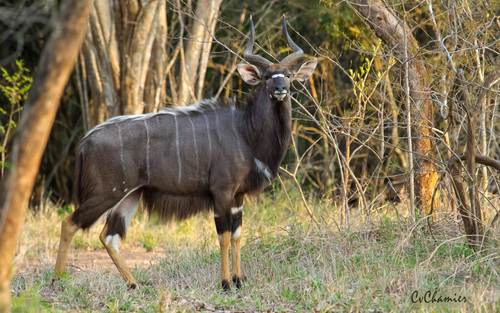
Nyala
The majestic Nyala (Tragelaphus angasii) graces southern Africa's woodlands. Males boast impressive spiral horns and rich, dark coats, while females display vibrant russet hues. These antelopes thrive near water, embodying grace and adaptability. Their striking sexual dimorphism and social behaviors highlight their ecological role in diverse habitats.
18.5 year
Lifespan
98.0 - 125.0 kg
Weight
Length: 1.346 - 1.956 m; Height: 1.097 m
Size
Brown, Yellow, White
Color
11-12 months
Age of Sexual Maturity
7 months
Age of Weaning
36 mph
Top Speed
Least Concern
Conservation Status
Stable
Population Trend
Characteristics
Tragelaphus angasii, also known as the Nyala, is a spiral-horned antelope native to southern Africa. They inhabit dense thickets, woodlands, and areas near water. Males are larger, with striking spiral horns and a dark, shaggy coat, while females are smaller, with a lighter, reddish-brown coat. Nyalas are known for their sexual dimorphism and distinctive white markings.
Distribution Range of the Nyala
Tragelaphus angasii, commonly known as the Nyala, is native to southeastern Africa. Its geographical distribution includes countries such as Malawi, Mozambique, South Africa, Swaziland, and Zimbabwe. The species is predominantly found in the southeastern regions of Africa, with a significant presence in protected reserves and national parks within these countries.
Nyala's Habitat
Environmental Conditions
The Nyala typically inhabits dense thickets and riverine woodlands, often near water sources. These areas are characterized by a subtropical climate with distinct wet and dry seasons. The vegetation in these habitats includes a mix of evergreen and deciduous trees, thick underbrush, and grasslands, providing ample cover and food resources.
Ecological Niche
Nyala are browsers, feeding on leaves, twigs, and fruits, which they find in the lower strata of dense vegetation. They are well-adapted to their environments, with a preference for areas that offer both cover and food. The presence of water is crucial as they require frequent access to drinking sources. Their ecological role includes seed dispersal and serving as prey for larger predators such as lions and leopards.
Copyright @ Nature Style Limited. All Rights Reserved.
 English
English